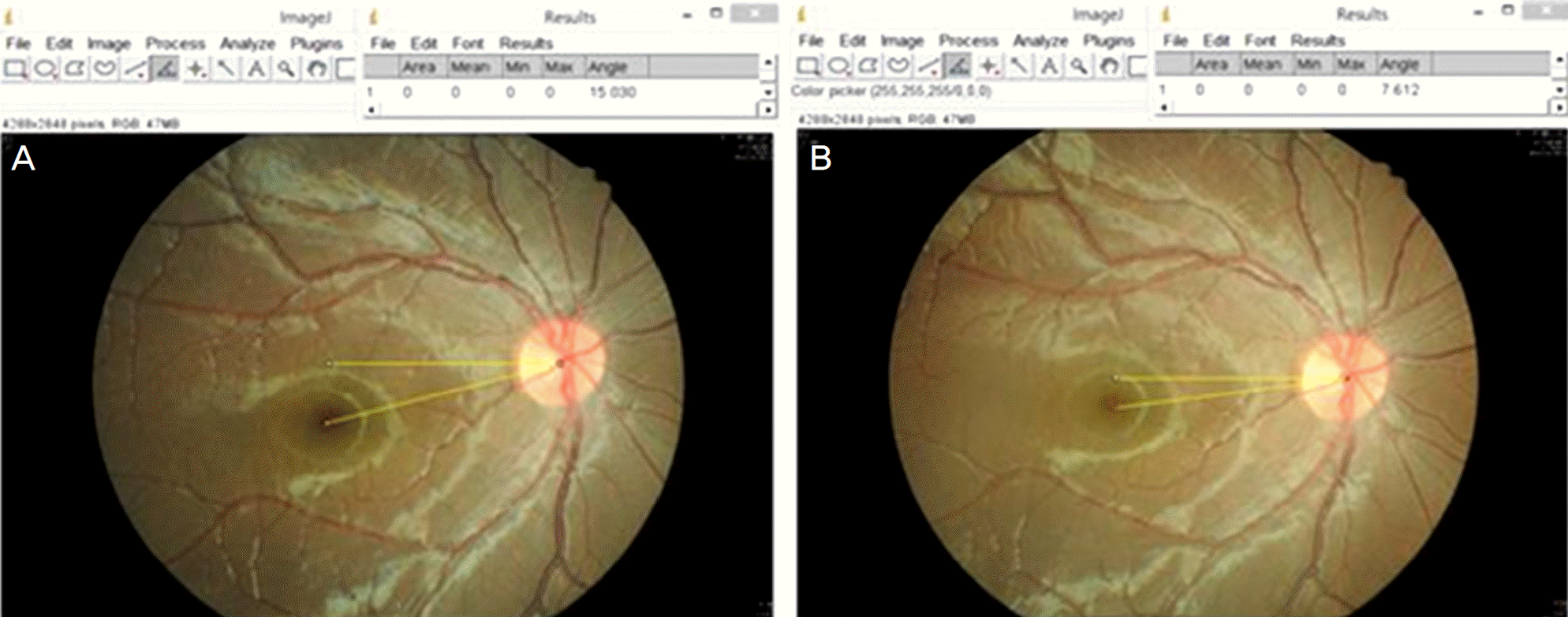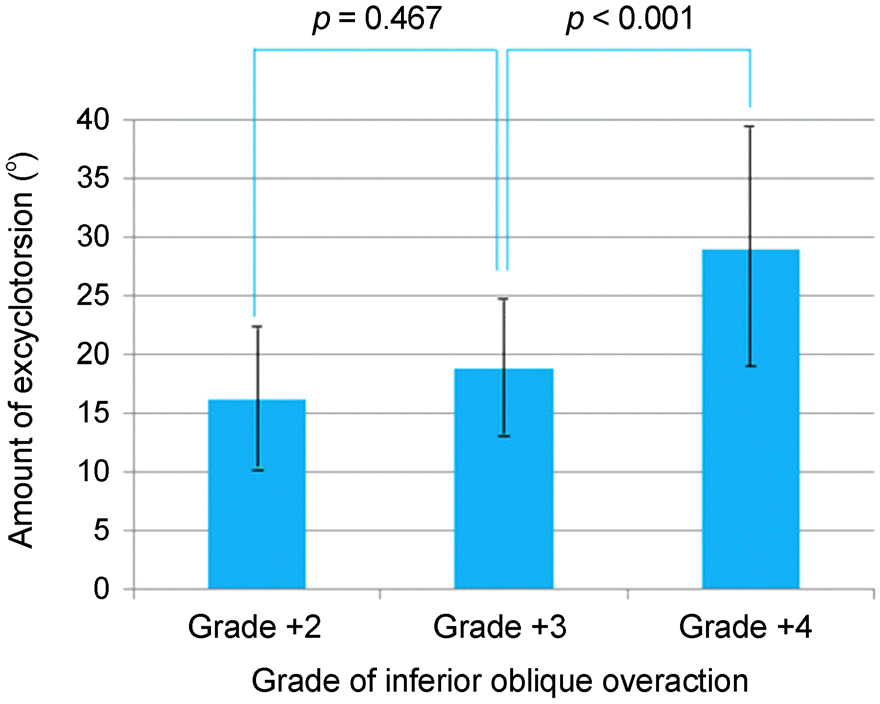Abstract
Purpose
To investigate changes in ocular excyclotorsion in patients with inferior oblique overaction (IOOA) according to amount of correction by graded inferior oblique recession and to compare the amount of excyclotorsion between primary IOOA and secondary IOOA.
Methods
This study included 54 eyes of 54 patients who were diagnosed with unilateral IOOA and underwent graded inferior oblique recession. Fundus photographs were taken pre- and postoperatively. The sum of angles of torsion of both eyes was used to analyze changes in excyclotorsion. The angle of excyclotorsion was analyzed using the ImageJ program.
Results
Eighteen eyes were grade 2, 24 eyes were grade 3 and 12 eyes were grade 4. Preoperative angle of excyclotorsion was 16.23 ± 5.96˚ for the patients with grade 2 eyes, 18.83 ± 5.76˚ for the patients with grade 3 eyes and 29.00 ± 10.23˚ for the patients with grade 4 eyes. Therefore, as the degree of IOOA increased, the amount of excyclotorsion became larger. There was no statistical significance between grade 2 and grade 3 (p = 0.467), however, there was a statistically significant difference between grade 3 and grade 4 (p < 0.001). Postoperative angle of excyclotorsion was significantly decreased in each group (grade 2: p = 0.020, grade 3: p < 0.001, grade 4: p = 0.041). The amount of surgical recession of inferior oblique muscle showed a positive correlation with a decrease in the angle of excyclotorsion, but was not statistically significant. The amount of excyclotorsion and the decrease of excyclotorsion after surgery were larger in secondary IOOA than in primary IOOA, but were not statistically significant (p = 0.260).
Go to : 
References
1. White JW, Brown HW. Occurrence of vertical anomalies abdominal with convergent and divergent anomalies: a clinical study. Arch Ophthalmol. 1939; 21:999–1009.
2. Wright KW, Hakim OM. Alphabet patterns and oblique muscle dysfunction. Wright KW, Strube YNJ, editors. Pediatric Ophthalmology and Strabismus. 3rd ed.New York: Oxford University Press;2012. chap. 20.
3. Hong JS, Kim MM. abdominal outcome of graded inferior oblique recession. J Korean Ophthalmol Soc. 2006; 47:127–32.
4. Del Monte MA, Parks MM. Denervation and extirpation of the abdominal oblique. An improved weakening procedure for marked overaction. Ophthalmology. 1983; 90:1178–85.
5. Paik HJ, Choi JS. Comparison of Recession, anterior transposition, and myectomy for inferior oblique overaction. J Korean Ophthalmol Soc. 2006; 47:600–6.
6. Min BM, Park JH. Comparison between myectomy and anterior transposition on inferior oblique overaction. J Korean Ophthalmol Soc. 1992; 33:977–82.
7. Parks MM. The weakening surgical procedures for eliminating overaction of the inferior oblique muscle. Am J Ophthalmol. 1972; 73:107–22.

8. Kim JW, Kim MM. The effect of inferior oblique weakening abdominal in the congenital superior oblique palsies. J Korean Ophthalmol Soc. 2004; 45:1893–8.
9. Park JH, Kang SH, Choi DG. Analysis of effect of inferior oblique myectomy in patients with inferior oblique overaction. J Korean Ophthalmol Soc. 2011; 52:67–73.

11. Roh YB, Jung DY. The role of preoperative indirect ophthalmoscopy under general anesthesia for diagnosis of torsional strabismus. J Korean Ophthalmol Soc. 1998; 39:1552–7.
12. Sim JH, Lee SY. The effect of inferior oblique weakening abdominal on the correction of ocular torsion. J Korean Ophthalmol Soc. 2005; 46:1020–6.
13. Cho SY, Lee SY, Lee YC. Clinical evaluation of excyclotorsion in patients with primary inferior oblique overaction. J Korean Ophthalmol Soc. 2012; 53:1324–9.

14. Parks MM. Atlas of Strabismus Surgery. 1st ed.Philadelpia: Harper and Row Publishers;1983. p. 167–87.
15. von Noorden GK, Campos EC. Binocular Vision and Ocular Motility. 6th ed.Philadelphia: CV Mosby;1973. p. 177.
16. Na KS, Lee SY, Lee YC. Ocular torsion in unilateral superior abdominal palsy. J Korean Ophthalmol Soc. 2007; 48:1388–93.
18. von Noorden GK. Clinical and theoretical aspects of cyclotropia. J Pediatr Ophthalmol Strabismus. 1984; 21:126–32.

19. Rosenbaum AL, Santiago AP. Clinical Strabismus Management: Principles and Surgical Techniques. 1st ed.Philadelphia: W.B. Saunders Company;1999. p. 55–9.
20. Madigan WP Jr, Katz NN. Ocular torsion-direct measurement with indirect ophthalmoscope and protractor. J Pediatr Ophthalmol Strabismus. 1992; 29:171–4.

21. Locke JC. Heterotopia of the blind spot in ocular vertical muscle imbalance. Trans Am Ophthalmol Soc. 1967; 65:306–32.

22. Guyton DL. Ocular torsion reveals the mechanisms of cyclo-vertical strabismus: the Weisenfeld lecture. Invest Ophthalmol Vis Sci. 2008; 49:847–57. 846.

23. Bixenman WW, von Noorden GK. Apparent foveal displacement in normal subjects and in cyclotropia. Ophthalmology. 1982; 89:58–62.

24. Lee DH, Lee SJ, Park SH. Ocular torsion in normal Korean population. J Korean Ophthalmol Soc. 2004; 45:797–802.
25. Park SW. The torsional status of normal Koreans. J Korean Ophthalmol Soc. 2004; 45:1906–11.
26. Song MH, Lee SY, Lee YC. The relationship of hypertropia, abdominal oblique overaction and extorsion in congenital superior abdominal palsy. J Korean Ophthalmol Soc. 2007; 48:1394–8.
27. Arici C, Oguz V. The effect of surgical treatment of superior abdominal muscle palsy on ocular torsion. J AAPOS. 2012; 16:21–5.
Go to : 
 | Figure 1.The angle of excyclotorsion measured using ImageJ program. The angle significantly decreased after graded inferior oblique recession. (A) Preoperative measurement. (B) Postoperative measurement. |
 | Figure 2.Comparison of amount of preoperative excyclotorsion according to inferior oblique overaction grade using ANOVA test. Values are presented as mean ± SD. |
Table 1.
Baseline characteristics of patients
Table 2.
Changes in excyclotorsion after graded inferior oblique recession
| N | Preoperative angle of excyclotorsion (˚) | Postoperative angle of excyclotorsion (˚) | Amount of correction (˚) | p-value* | |
|---|---|---|---|---|---|
| IOOA Grade +2 | 18 | 16.23 ± 5.96 | 13.68 ± 6.26 | 2.56 ± 4.24 | 0.020 |
| IOOA Grade +3 | 24 | 18.83 ± 5.76 | 14.77 ± 6.36 | 4.06 ± 4.87 | <0.001 |
| IOOA Grade +4 | 12 | 29.00 ± 10.23 | 22.67 ± 8.73 | 6.33 ± 6.01 | 0.041 |
| Total | 54 | 20.23 ± 8.44 | 16.16 ± 7.65 | 4.06 ± 5.05 | <0.001 |
Table 3.
Comparison of amount of excyclotorsion between primary IOOA and secondary IOOA
| N | Preoperative angle of excyclotorsion (˚) | Postoperative angle of excyclotorsion (˚) | Amount of correction (˚) | p-value* | |
|---|---|---|---|---|---|
| Primary IOOA | 13 | 16.31 ± 5.94 | 13.63 ± 6.26 | 2.68 ± 4.23 | 0.042 |
| Secondary IOOA | 41 | 21.46 ± 8.79 | 16.97 ± 7.94 | 4.50 ± 5.25 | <0.001 |




 PDF
PDF ePub
ePub Citation
Citation Print
Print


 XML Download
XML Download